Click on images to enlarge
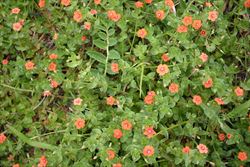
infestation of scarlet pimpernel (Photo: Sheldon Navie)

habit of blue pimpernel (Photo: Sheldon Navie)

habit of scarlet pimpernel (Photo: Sheldon Navie)

scarlet pimpernel (Anagallis arvensis var. arvensis) and blue pimpernel (Anagallis arvensis var. caerulea) growing together (Photo: Sheldon Navie)
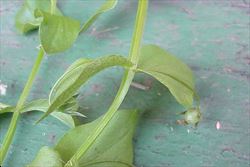
close-up of the four-sided stems and paired leaves (Photo: Sheldon Navie)
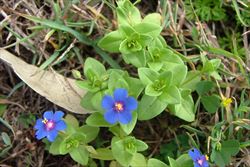
leaves and flowers of blue pimpernel (Photo: Sheldon Navie)
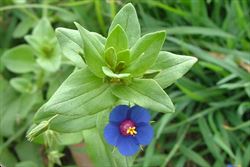
close-up of leaves and flower of blue pimpernel (Photo: Sheldon Navie)

close-up of scarlet pimpernel flowers (Photo: Sheldon Navie)

immature fruit (Photo: Sheldon Navie)
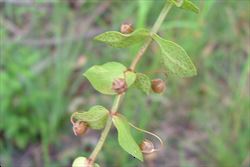
mature fruit, also note the blackish spots on the leaf undersides (Photo: Sheldon Navie)

close-up of seeds (Photo: Sheldon Navie)
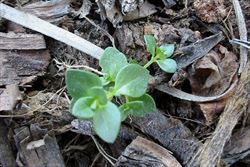
seedling (Photo: Sheldon Navie)
Scientific Name
Lysimachia arvensis (L.) U.Manns & Anderb.
Synonyms
Anagallis arvensis L.
Anagallis arvensis L. forma arvensis
Anagallis arvensis L. forma caerulea (L.) Ludi
Anagallis arvensis L. subsp. arvensis
Anagallis arvensis L. subsp. caerulea (Schreb.) Gren. & Godr.
Anagallis arvensis L. subsp. foemina (Mill.) Schinz & Thell.
Anagallis arvensis L. var. arvensis
Anagallis arvensis L. var. caerulea Gouan
Anagallis arvensis L. var. coerulea Gouan
Anagallis arvensis L. var. phoenicea Gouan
Anagallis caerulea L.
Anagallis caerulea Schreb.
Anagallis foemina Mill.
Family
Primulaceae (Victoria, the ACT, Tasmania, South Australia,
Western Australia and the Northern Territory)
Myrsinaceae (Queensland, New South Wales)
Common Names
bird's eye, bird's-eye, blue pimpernel, common pimpernel, pimpernel, poison chickweed, poisonous pimpernel, poisonweed, poor man's barometer, poor man's weather glass, poor man's weatherglass, poor-man's weatherglass, poorman's weatherglass, red chickweed, red pimpernel, scarlet pimpernel, shepherd's clock, shepherd's weather glass, shepherd's weatherglass, shepherd's-clock, wink-a-peep
Origin
Native to northern Africa (i.e. Algeria, Egypt, Libya, Morocco and Tunisia), the Azores, the Madeira Islands, the Canary Islands, Europe, western Asia, western China and the Indian sub-continent (i.e. India, Nepal, Pakistan and Sri Lanka).
Naturalised Distribution
Widely naturalised throughout large parts of Australia. It is widely naturalised in Queensland, New South Wales, Victoria, Tasmania and the ACT. Widespread in large parts of Western Australia and South Australia, but not found in the drier parts of these states. Also naturalised on Lord Howe Island and Norfolk Island.
Habitat
A common weed of pastures, crops, parks, lawns, gardens, roadsides, disturbed sites, waste areas, swamp margins, open woodlands, shrublands, grasslands, rocky outcrop vegetation and coastal environs. It is particularly common in temperate and sub-tropical environments, but is also occasionally found in tropical and semi-arid regions.
Habit
A short-lived (i.e. annual) herbaceous plant with low-growing (i.e. procumbent or decumbent) stems usually only 5-30 cm long, but occasionally reaching up to 50 cm in length. It is usually much less than 20 cm tall, but tends to be a little taller when growing amongst dense vegetation.
Distinguishing Features
- a small, low-growing and short-lived herbaceous plant with stems up to 50 cm long.
- its small soft green leaves (4-25 mm long and 3-15 mm wide) are oppositely arranged along its four-angled stems.
- its flowers have five brightly-coloured petals (4-6 mm long) that are either reddish-orange or purplish-blue in colour.
- its small rounded capsules (3-6 mm long and 3-5 mm wide) turn from green to pale brown as they mature.
Seedling
The two seed-leaves (i.e. cotyledons) are somewhat triangular in shape with a round tip (i.e. obtuse apex). They are hairless (i.e. glabrous), about 6 mm long, and borne on short stalks (i.e. petioles). The first pair of true leaves are egg-shaped in outline (i.e. ovate) and do not have any stalks (i.e. they are sessile). These leaves are also hairless (i.e. glabrous) and often have many dark spots on their undersides.
Stems and Leaves
The stems never become wiry, tending to remain soft and green, and are four-angled (i.e. quadrangular) in cross-section. They are hairless (i.e. glabrous)
The small leaves are oppositely arranged along the stems and stalkless (i.e. sessile). These leaves (4-25 mm long and 3-15 mm wide) are egg-shaped in outline (i.e. ovate or narrowly-ovate) with entire margins. They are hairless (i.e. glabrous) with rounded to pointed tips (i.e. obtuse to acute apices).
Flowers and Fruit
The flowers are borne singly on stalks (i.e. pedicels) 15-22 mm long emanating from the leaf forks (i.e. axils). These flowers have five round (i.e. orbicular) petals (4-6 mm long), which are fused together at the base, and five yellow stamens. There are two forms, one with orange of reddish-coloured flowers (usually known as scarlet pimpernel, or Anagallis arvensis var. arvensis) and the other with blue or purplish-coloured flowers (usually known as blue pimpernel, or Anagallis arvensis var. caerulea ). They also have five narrow, green, sepals (3-6 mm long) and an ovary topped with a style (4-6 mm long) and tiny stigma. Flowering occurs mainly from late winter through to late summer (i.e. from August to March).
The small rounded capsules (3-6 mm long and 3-5 mm wide) turn from green to pale brown as they mature. They eventually open by a crosswise slit, like a lid, to release their seeds (i.e. they are circumscissile).
Reproduction and Dispersal
This species reproduces only by seed, which may be dispersed by water or in mud attached to vehicles or animals. They are also spread in dumped garden waste, contaminated agricultural produce (e.g. fodder and pasture seed lots), and in nursery pots used in revegetation projects.
Environmental Impact
Pimpernel (Anagallis arvensis) is regarded as an environmental weed in Victoria, South Australia, Western Australia and New South Wales. While it is a small and inocuous-looking plant, it can form dense populations in understorey vegetation that exclude native species.
In Western Australia it grows in a wide range of natural habitats including along the edges of swamps, on rocky outcrops, in coastal areas, and in shrublands and grasslands. It is often found in disturbed natural vegetation and was ranked as a moderately important species in the recent Environmental Weed Strategy of Western Australia.
In South Australia, pimpernel (Anagallis arvensis) has been recognised as an aggressive weed that can be invasive in intact native vegetation and is capable of producing dense stands that threaten native plant diversity. However, it has also been described as seldom being invasive, except possibly inhibiting the native herb layer of vegetation. This species has been recorded in numerous conservation areas in this state (e.g. Cobbler Creek Recreation Park, Totness Recreation Park, Cox Scrub Conservation Park, Montacute Conservation Park, Ferguson Conservation Park, Naracoorte Caves Conservation Park, Coorong National Park and Marino Conservation Park).
Pimpernel (Anagallis arvensis) is regarded as a serious threat to one or more vegetation formations in Victoria and is listed as a common weed of riparian shrublands and floodplain riparian woodlands in this state. It appears on some local and regional environmental weed lists (e.g. in Knox City, Banyule City, the Shire of Nillumbik and the Goulburn Broken Catchment) and has also been recorded in several conservation areas (e.g. Phillip Island Nature Park, Larconbes Nature Reserve, Mount Mercer Nature Conservation Reserve, Rutherglen Nature Conservation Reserve, Brisbane Ranges National Park and Organ Pipes National Park) in Victoria.
In other states pimpernel (Anagallis arvensis) is of lesser concern. However, it is listed as an environmental weed in the wider Sydney and Blue Mountains region and has been recorded in conservation areas in Tasmania (e.g. in Greens Beach/Kelso Coastal Reserve and Don River Reserve).
Other Impacts
Pimpernel (Anagallis arvensis) is a common weed of many crops (e.g. cereals, vegetables, cotton, brassica crops, summer crops, lucerne and legumes). It is also poisonous to livestock (e.g. horses, sheep and cattle), domestic animals (e.g. birds, dogs, guinea pigs and rabbits) and humans.
Legislation
Not declared or considered noxious by any state or territory government in Australia.
Similar Species
There are two distinct forms of this species, scarlet pimpernel (Anagallis arvensis var. arvensis), which has orange or reddish-coloured flowers, and blue pimpernel (Anagallis arvensis var. caerulea), which has dark blue or purplish-coloured flowers.
Pimpernel (Anagallis arvensis) is also similar to chaffweed (Anagallis minima) when not in flower. However, chaffweed (Anagallis minima) is even smaller in stature (with stems less than 10 cm long), has smaller white or pinkish flowers (with petals 1-2 mm long), and has alternately arranged leaves.

